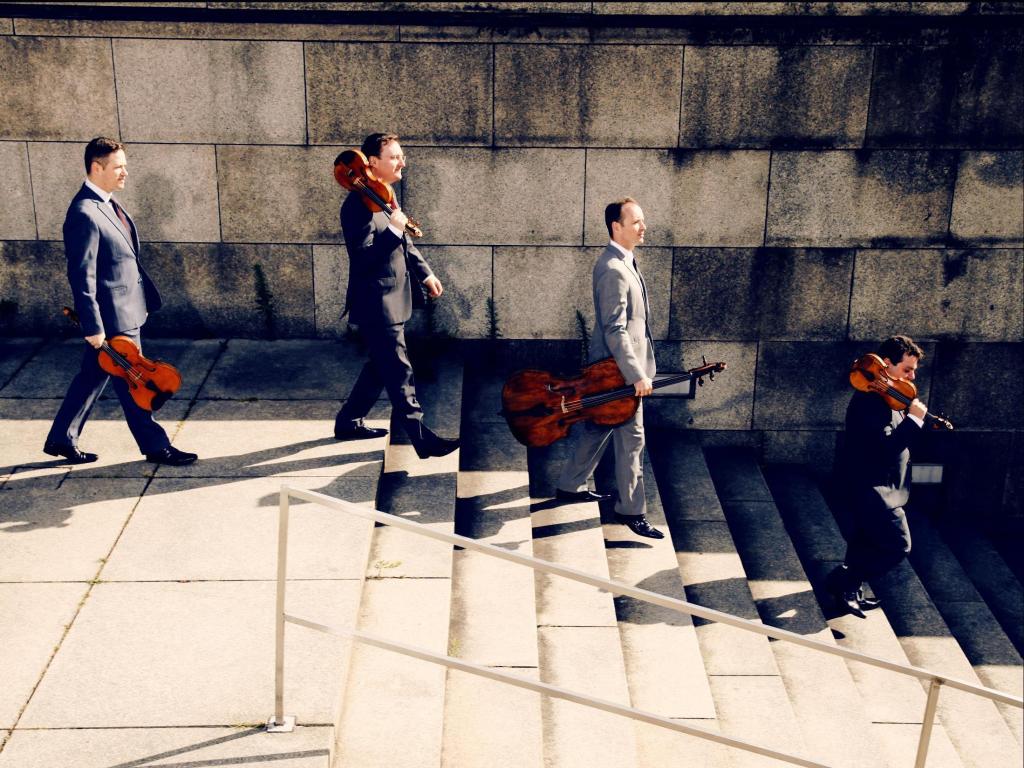Jerusalem Quartet, photograph by Felix Broede.
This year the Jerusalem Quartet celebrates 21 years of playing together. The only new musician is the violist, Ori Kam, who joined the ensemble in 2010. This performance was the last concert in the quartet’s seventh national tour for Musica Viva Australia since 2001. In addition, and as is now customary for many Musica Viva international artists, three undoubtedly valuable masterclasses were staged around the country.
And so there was a strong sense of warmth and familiarity within the nearly full Elisabeth Murdoch Hall in Melbourne on Tuesday night. The Quartet has a well-established ‘voice’ and style: an enviable rapport that enjoys articulated detail, melds the sound of all four instruments into a whole with elegant phrasing and generally reliable intonation and seeks a unified narrative. The preferred sound is big but can occasionally stray into abrasiveness, though nothing that could be regarded as objectionable. However, I found it somewhat frustrating that this ‘voice’ and style was applied to all three works on the program with little variation: Haydn’s Classical String Quartet, Op 64 No 5 ‘The Lark’, Australian composer Ross Edwards’s String Quartet No 3 ‘Summer Dances’ (2012) and Beethoven’s String Quartet No 7 in F major, Op 59 No 1 ‘Razumovsky’.
1790 was an unusually disruptive year for Haydn. In February both Emperor Joseph II and Prince Nicolaus Esterházy’s wife died, followed in September by the death of the Prince himself. Anton, his heir, soon dissolved the musical establishment at Esterháza, obliging Haydn to move to Vienna. It was in Vienna that the Op 64 set of quartets was composed from September to December with, indeed, a faintly commercial intent behind them. The work was ‘violin led’ so as to demonstrate the talents of Haydn’s associate and colleague Johann Tost, a member of the Esterháza Orchestra who also at the time needed to make plans for the future. The refined Classical architecture of the work, clean-lined, handsome and elegant was reasonably well conveyed by the ensemble, though it felt hefty. Simple strong-weak cadences should have been delivered as such. The Adagio cantabile was overly romantic and unnecessarily sophisticated, almost suggesting that the music needed to be ‘filled in’ owing to there being something missing. The Menuetto: Allegretto similarly could have been more fleet-footed and simply enjoyed for its fun.
Ross Edwards’s fine String Quartet No 3 presents familiar compositional technique developed over decades to describe the joy of bush walks and the accompanying sounds of birds and insects of the Sydney region. There is a sunny cheerfulness to the work along with a profound and elated sense of the spiritual that seeks to experience and celebrate a connection with our landscape similar in intensity and authenticity even to that experienced by Australia’s First Peoples. In five movements, the work lays out bands of static material in juxtaposition to jubilant music portraying the vitality of fauna literally jumping for joy. The Jerusalem Quartet, having played another Musica Viva commission by Ross Edwards, the Octet for strings Veni Creator Spiritus, has had experience with his music and gave an engaging performance. What was missing was clarity of articulation in the faster ‘Maninya’-inspired sections, a need to simply leave alone material such as the section marked Puro e semplice, a sharpening of focus on contrast between sections, and a certain understanding of the necessary ‘dryness’ inherent in this music (similar, indeed, to that of the late Peter Sculthorpe) which is probably unexplainable. The unmarked accelerando in the work’s final bars did not convince.
Although I am familiar with listening to Beethoven’s first Razumovsky quartet, I wondered if the Jerusalem Quartet was familiar with playing it. I was struck on this occasion by how complicated it is and felt its bones were laid bare. Knowing that Beethoven had lost most of his hearing at this stage of his life, I found myself focusing on the work’s unusual and unexpected narrative. It seemed to me that Beethoven leaves out regular passages that we complete in our minds as the music progresses. The second movement particularly (Allegretto vivace e sempre scherzando) could have been more finessed in terms of shape and clear narrative. Most successful was the third movement (Adagio molto e mesto), a touching aria passed between voices interchanged and embellished and reaching heart-wrenching emotional peaks before breaking up into short sighs. This was transcendental writing beautifully conveyed. Most remarkable was that as my seat was quite close to the stage I witnessed the violist apparently playing the entire work from memory, though he may have been reading from an iPad.
Rating: 3.5 stars out of 5
Jerusalem Quartet
International Concert Season
Presented by Musica Viva Australia
Elisabeth Murdoch Hall, Melbourne Recital Centre
Tuesday, 27 September, 2016





